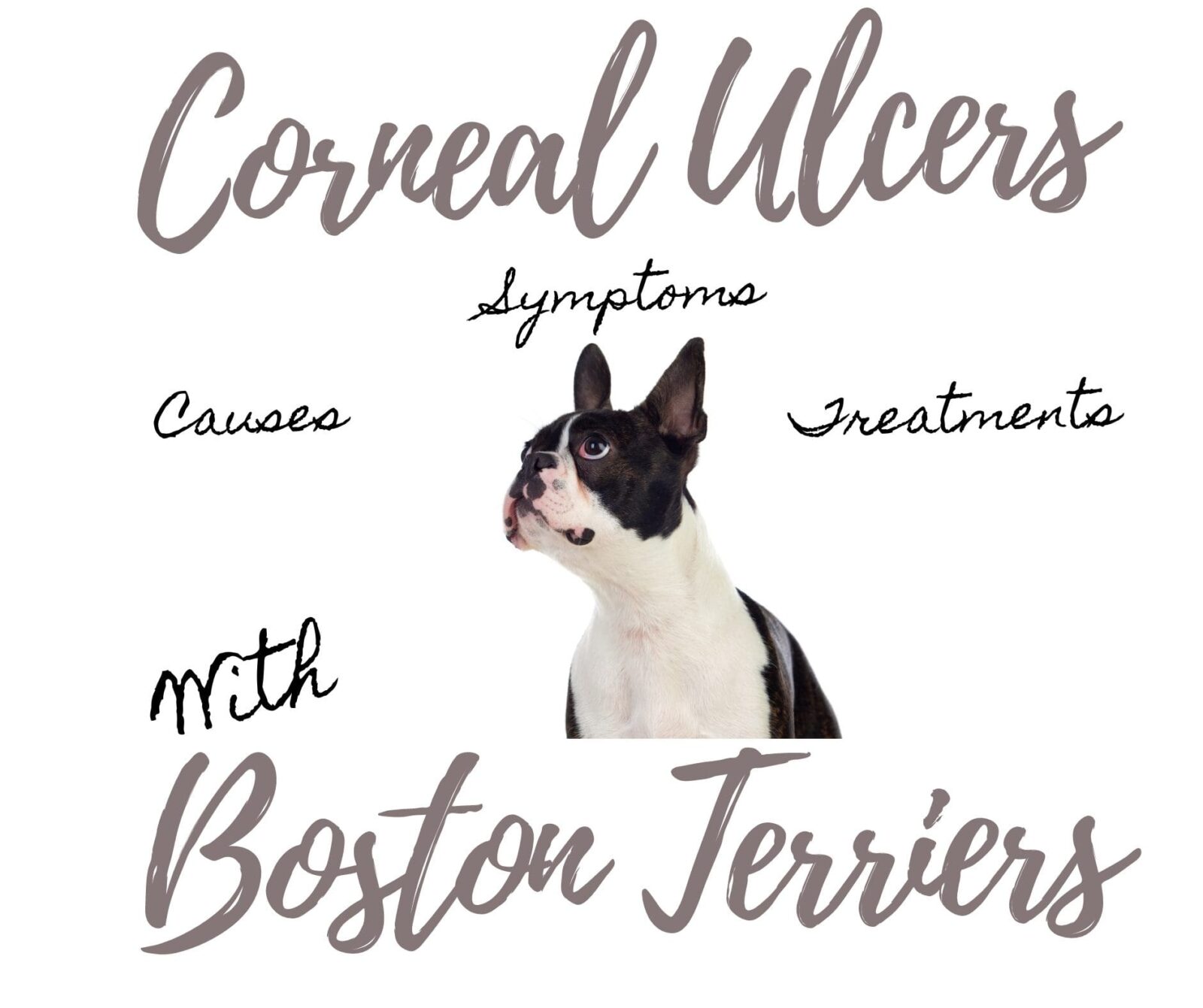Introduction
Corneal ulcers, a serious eye condition, can affect Boston Terriers, causing discomfort and potentially leading to vision issues if not promptly addressed. In this article, we’ll delve into the details of corneal ulcers, exploring their causes, symptoms, stages, treatment, and whether they can heal on their own.
To see an overview on other Boston Terrier Eye Issues, click here.

What Causes Corneal Ulcers in Boston Terriers?
In Summary:
- Trauma: Accidental injury to the eye, scratches, or foreign objects can cause corneal ulcers.
- Infections: Bacterial, viral, or fungal infections may lead to corneal ulcers if left untreated.
- Dry Eye (Keratoconjunctivitis Sicca): Insufficient tear production can cause dryness, leading to corneal ulcers over time.
- Entropion or Ectropion: Eyelid abnormalities where the eyelids roll inwards (entropion) or outwards (ectropion) can cause irritation and corneal ulcers.
Corneal ulcers, a prevalent eye condition among Boston Terriers, can arise from a variety of sources. Understanding the causes is crucial to prevent, manage, and treat these ulcers effectively. Here, in more depth, are some common causes of corneal ulcers in Boston Terriers:
- Trauma:
Corneal ulcers in Boston Terriers can result from accidental trauma to the eye. Scratches or injuries, often caused by foreign objects or rough play, can damage the cornea’s delicate surface and trigger the formation of an ulcer.
Boston Terriers, known for their playful nature, are susceptible to eye trauma during playtime or outdoor activities. The eye’s exposure to potential hazards makes them prone to accidental injuries.
- Infections:
Bacterial, viral, or fungal infections in the eye can lead to corneal ulcers if left untreated. These infections may originate from foreign substances or from pre-existing eye conditions that weaken the cornea’s defense mechanisms.
Boston Terriers, like many dog breeds, are vulnerable to eye infections. Maintaining good eye hygiene and seeking prompt medical attention for any signs of infection is crucial in preventing corneal ulcers.
- Dry Eye (Keratoconjunctivitis Sicca):
Dry eye, a condition where the eye fails to produce sufficient tears, can cause corneal ulcers due to the resulting dryness. Tears play a crucial role in maintaining the cornea’s health, and inadequate tear production can lead to irritation, inflammation, and ulceration.
Boston Terriers are predisposed to dry eye, making them more susceptible to corneal ulcers. Regular monitoring and appropriate management of this condition can help prevent associated ulcers.
- Eyelid Abnormalities (Entropion or Ectropion):
Eyelid abnormalities like entropion (inward rolling) or ectropion (outward rolling) can cause constant irritation to the cornea. The abnormal position of the eyelids can lead to friction, scratching, and rubbing against the cornea, potentially resulting in ulcers.

Boston Terriers may experience these eyelid abnormalities, increasing their risk of developing corneal ulcers. Regular check-ups with a veterinarian can aid in early detection and intervention to mitigate the risk of ulcers.
Understanding these potential causes of corneal ulcers in Boston Terriers empowers pet owners to take proactive steps in maintaining their dog’s eye health. Prompt recognition of symptoms and timely veterinary care are essential to minimize the risk of corneal ulcers and ensure a happy, healthy life for your Boston Terrier.

Symptoms and Stages of Corneal Ulcers
Recognizing the signs of corneal ulcers is crucial for timely intervention.
In summary, symptoms may include:
- Eye Pain and Discomfort: Your Boston Terrier may display signs of discomfort, such as pawing at the eye or excessive blinking.
- Excessive Tearing: The affected eye may produce more tears than usual.
- Cloudiness or Opacity: The cornea might appear cloudy or have a white spot, indicating an ulcer.
- Redness and Swelling: Inflammation of the eye and redness in the white part (sclera) can be observed.
Corneal ulcers progress through stages:
- Epithelial Defect: The outer layer of the cornea is damaged, creating an ulcer.
- Stromal Ulcer: Deeper layers of the cornea are affected, potentially leading to severe complications.
Timely recognition of corneal ulcers in your Boston Terrier is essential to ensure prompt intervention and prevent potential complications. The signs and symptoms of corneal ulcers can be subtle at the onset, but vigilant pet owners can identify them with careful observation. Here are key signs of corneal ulcers and the stages of their progression:
Signs, Symptoms and Stages: A Deeper Look
1. Eye Pain and Discomfort:
Your Boston Terrier may exhibit signs of discomfort due to the ulcer. Pawing at the eye, excessive blinking, or rubbing the affected eye are common indicators of eye pain. If your pet displays these behaviors, it’s crucial to inspect the eye for potential issues.
2. Excessive Tearing:
Corneal ulcers can stimulate an increased production of tears in an attempt to soothe the eye. Excessive tearing, often accompanied by a noticeable dampness around the affected eye, is a common symptom of corneal ulcers.
3. Cloudiness or Opacity:
As the ulcer progresses, the cornea can develop cloudiness or a white spot. This change in the cornea’s appearance is a clear indication of an ulcer. If you notice any unusual opacity or cloudiness, consult your veterinarian promptly.
4. Redness and Swelling:
Inflammation is a typical response to corneal ulcers. The affected eye may exhibit redness and swelling, particularly in the white part (sclera). The redness and swelling are visible signs of an ongoing issue in the eye.

Stages of Corneal Ulcer Progression:
a. Epithelial Defect:
The initial stage involves the damage to the outer layer of the cornea, resulting in an epithelial defect. At this stage, the ulcer is at its early phase, and intervention can prevent it from progressing to a deeper level.
b. Stromal Ulcer:
If left unattended, the ulcer may progress to the stromal stage, affecting deeper layers of the cornea. Stromal ulcers are more severe and can lead to complications. Timely medical attention is crucial to mitigate the risk of complications and facilitate a successful recovery.
By being vigilant and attentive to any unusual behaviors or signs of discomfort your Boston Terrier displays, you can play a pivotal role in identifying potential corneal ulcers. Early detection enables timely veterinary intervention, enhancing the chances of a successful treatment outcome and preserving your pet’s precious eyesight and overall well-being.
Can Corneal Ulcers Heal Themselves?
Corneal ulcers usually do not heal on their own. Veterinary intervention is essential for proper assessment and treatment. If a corneal ulcer is superficial, your veterinarian might recommend eye drops or ointments to facilitate healing. However, deeper ulcers usually require more extensive treatments.
Treatment of Corneal Ulcers
The treatment plan depends on the severity and stage of the ulcer. To summarize:
- Medication: Antibiotic, antifungal, or antiviral eye drops or ointments may be prescribed to tackle infections.
- Pain Management: Pain relievers to alleviate discomfort and pain associated with the ulcer.
- Surgery: In severe cases, surgery may be necessary to debride the ulcerated area and promote healing. This can involve removing the affected corneal tissue.
- Collagen Shields: These are thin, transparent discs that can be placed over the ulcer to facilitate healing.
Effective Treatment Strategies for Corneal Ulcers in Boston Terriers: A Deeper Look
Ensuring appropriate and timely treatment for corneal ulcers in Boston Terriers is vital to prevent further complications and promote a swift recovery. Treatment approaches vary based on the severity and stage of the ulcer. Here are some essential treatment modalities:
1. Medication:
- Antibiotics, Antifungals, or Antivirals: Depending on the underlying cause, your veterinarian may prescribe specific eye drops or ointments to combat infections effectively. These medications are crucial in managing the ulcer and preventing its progression.
2. Pain Management:
- Pain Relievers: Addressing the pain and discomfort associated with corneal ulcers is an essential aspect of treatment. Your veterinarian may recommend pain relievers to alleviate the pet’s discomfort and aid in the healing process.
3. Surgery:
- Debridement and Tissue Removal: In severe cases where the ulcer has advanced significantly or is unresponsive to other treatments, surgical intervention may be necessary. Surgery involves carefully removing the affected corneal tissue to facilitate the growth of healthy tissue and enhance the healing process.
4. Collagen Shields:
- Promoting Healing with Transparent Discs: Collagen shields, transparent and thin discs, can be placed over the ulcerated area. These shields aid in the healing process by providing a protective layer over the ulcer, facilitating tissue regeneration and recovery.
5. Protective Measures:
- Elizabethan Collar (E-collar): To prevent further irritation and trauma to the affected eye, using an E-collar is often recommended. This ensures that your Boston Terrier doesn’t paw at or scratch the eye, allowing it to heal without additional damage.
6. Follow-Up Care:
- Regular Veterinary Check-ups: Timely follow-up visits to the veterinarian are crucial for monitoring progress, adjusting the treatment plan if needed, and ensuring a successful recovery. Your vet will assess the healing process and recommend any modifications to the treatment strategy.
7. Addressing Underlying Issues:
- Managing Dry Eye (Keratoconjunctivitis Sicca): If the corneal ulcer is a result of dry eye, addressing the underlying cause by managing tear production with artificial tears or specific medications is vital to prevent recurrence.
It’s essential to adhere strictly to the treatment plan outlined by your veterinarian and administer any prescribed medications as directed. Prompt and appropriate treatment significantly increases the likelihood of a successful recovery, allowing your beloved Boston Terrier to regain comfort and vision.
Always consult a qualified veterinarian for tailored advice and treatment plans based on your Boston Terrier’s individual health needs and the specific characteristics of the corneal ulcer.

Recognizing Healing of Corneal Ulcers in Dogs
Healing time for corneal ulcers in Boston Terriers varies based on factors like the ulcer’s severity, treatment approach, and the dog’s overall health. Superficial ulcers may heal in a week or two, while deeper ulcers can take several weeks to months.
Corneal ulcers in dogs are concerning conditions that require vigilant care and attention. Monitoring the healing progress of a corneal ulcer is crucial to ensure your dog’s eye health. Here’s how you can tell if a corneal ulcer in your dog is healing:
1. Reduction in Symptoms:
- As the ulcer heals, your dog should show a decrease in signs of discomfort such as pawing at the eye, squinting, or rubbing the eye against surfaces.
2. Improved Eye Appearance:
- The affected eye should show signs of improvement. The cornea may become clearer, indicating a reduction in inflammation and cloudiness.
3. Decreased Discharge:
- If the ulcer was infected, any discharge from the eye should lessen and become less purulent as the ulcer heals.
4. Reduced Sensitivity to Light:
- The dog may become less sensitive to light, suggesting a decrease in the irritation caused by the ulcer.
5. Consultation with the Veterinarian:
- Regular follow-up appointments with your veterinarian are crucial during the healing process. The vet can assess the ulcer’s progress, make adjustments to the treatment plan if needed, and provide guidance on how to proceed.
6. Veterinary Examination:
- The veterinarian will use specialized equipment to examine the eye and monitor the ulcer’s size, depth, and overall healing progress.
7. Follow Treatment Instructions:
- Adhering to the prescribed treatment plan, which may include administering eye drops, ointments, or medications, is essential for effective healing. Make sure to follow the veterinarian’s instructions regarding medication dosage and administration.
8. Scheduled Rechecks:
- If your vet has scheduled rechecks, attending them is vital. These rechecks allow the vet to evaluate the progress and healing of the ulcer and adjust the treatment plan accordingly.
9. Avoiding Aggravation:
- Preventing any further irritation or injury to the eye is crucial during the healing process. Ensure your dog does not scratch or rub the affected eye, and keep the area clean.
10. Healing Timeline:
- Healing times vary depending on the ulcer’s severity. Shallow ulcers may heal within a week or two, while deeper or complicated ulcers may take several weeks to months.
Always consult your veterinarian if you have concerns about your dog’s corneal ulcer healing progress. They can provide guidance, reassurance, and adjust the treatment plan as needed to ensure a successful recovery and the best outcome for your Boston.

Conclusion
Corneal ulcers in Boston Terriers are a serious eye condition that demands prompt attention and appropriate treatment. If you suspect your Boston Terrier has a corneal ulcer, seek veterinary care immediately.
Early intervention can prevent complications and promote a faster and smoother recovery. Always prioritize your pet’s eye health and consult a veterinarian for any concerns regarding corneal ulcers or other eye conditions.
To see an overview on other Boston Terrier Eye Issues, click here.

https://www.bostonterriersociety.com/boston-terrier-eye-ulcers/
This post contains affiliate links. I earn from qualifying Amazon purchases.




